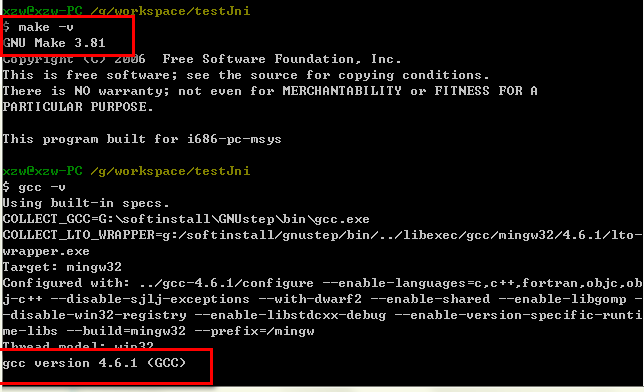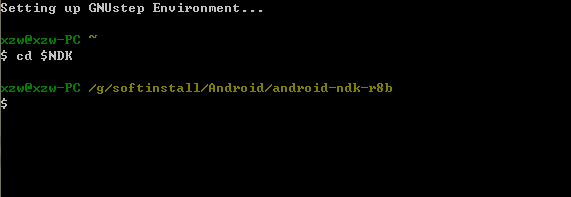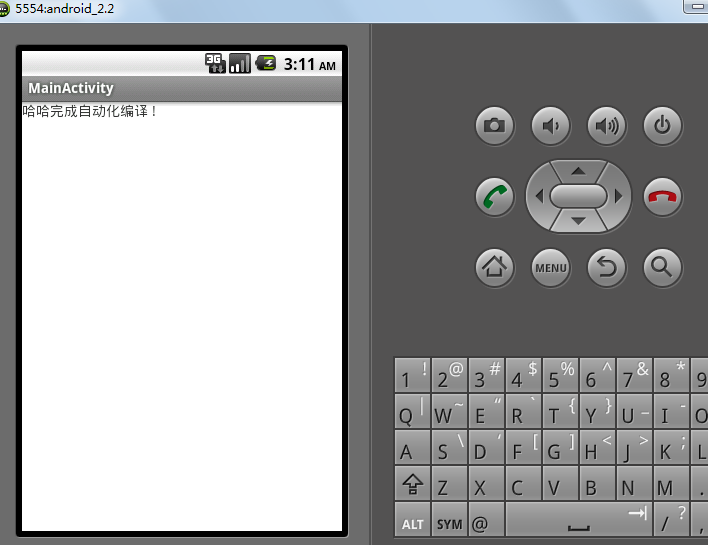这几天一直在研究JNI的开发过程,顺便把NDK环境搭建一起总结下。在windows环境下开发jni需要c/c++编译器的支持,网络上我看很多人使用cygwin。呵呵我不是很喜欢使用它,感觉安装起来挺麻烦的。我使用GNUStep,下载地址http://www.gnustep.org/experience/Windows.html。

下载安装后,验证是否成功。打开GNUstep->Shell,输入make -v 和 gcc -v命令,如图所示。

配置ndk环境变量,gnustep是模拟linux的环境的,打开gnustep的安装目录下的G:\softinstall\GNUstep\GNUstep\GNUstep.conf文件,添加以下内容:
NDK=/g/softinstall/Android/android-ndk-r8b
export=NDK
说明如果不知道ndk目录在linux下应该是在哪里,你可以打开gnustep的命令窗口,输入mount,就可以找到对应的盘符。
验证环境变量,如下图。 
以上就配置成功了。
下载进入正题啦。Jni的开发步骤。
打开eclipse,新建工程名为testJni。在activity中添加以下代码
packagecom.xzw.jni;
importandroid.os.Bundle;
importandroid.app.Activity;
importandroid.view.Menu;
importandroid.view.MenuItem;
importandroid.widget.TextView;
importandroid.support.v4.app.NavUtils;
/**
*
* @author XuZhiwei (xuzhiwei@gmail.com)
* sina:http://weibo.com/xzw1989
*
* Create at 2012-8-30 上午10:49:45
*/
publicclassMainActivityextendsActivity {
@Override
publicvoidonCreate(Bundle savedInstanceState) {
super.onCreate(savedInstanceState);
}
publicnativeString hello();
static{
System.loadLibrary("testJni");
}
}
编译后的文件在bin目录下,通过javah命令生成c/c++的文件头。如下图

会在项目目录下生成jni/com_xzw_jni_TestJni.h。
头文件代码如下:
/* DO NOT EDIT THIS FILE - it is machine generated */
#include
/* Header for class com_xzw_jni_TestJni */
#ifndef _Included_com_xzw_jni_TestJni
#define _Included_com_xzw_jni_TestJni
#ifdef __cplusplus
extern"C"{
#endif
/*
* Class: com_xzw_jni_TestJni
* Method: hello
* Signature: ()Ljava/lang/String;
*/
JNIEXPORT jstring JNICALL Java_com_xzw_jni_TestJni_hello
(JNIEnv *, jobject);
#ifdef __cplusplus
}
#endif
#endif
根据头文件编写c代码
#include
#include
jstring
Java_com_xzw_jni_TestJni_hello
(JNIEnv* env, jobject thiz){
return(*env)->NewStringUTF(env,"哈哈完成自动化编译 !");
}
接下来编写 Android.mk,该文件可以直接从NDK的samples下的hello-jni的jni文件下直接靠过来改改就可以了。也贴下代码哈。
# Copyright (C) 2009 The AndroidOpenSource Project
#
# Licensed under the Apache License, Version 2.0 (the "License");
# you may notuse this fileexceptincompliancewiththe License.
# You may obtain a copy ofthe Licenseat
#
# http://www.apache.org/licenses/LICENSE-2.0
#
# Unless required byapplicable laworagreedtoinwriting, software
# distributed under the License isdistributedonan"AS IS"BASIS,
# WITHOUT WARRANTIES ORCONDITIONSOFANYKIND, either expressorimplied.
# See the License forthe specific language governing permissionsand
# limitations under the License.
#
LOCAL_PATH := $(call my-dir)
include $(CLEAR_VARS)
LOCAL_MODULE := testJni
LOCAL_SRC_FILES := testJni.c
include $(BUILD_SHARED_LIBRARY)
其中你只需要该LOCAL_MODULE和LOCAL_SRC_FILES就可以了。
说明:LOCAL_MODULE是描述模块的,用来给java调用的模块名,会生成对应的libtestJni.so
LOCAL_SRC_FILES就是源文件啦,多个文件空格隔开即可。
接下来,我们要开始编译生成so文件咯。
打开gnustep的命令窗口,进入到项目底下,输入$NDK/ndk-build命令,即可自动生成libs/armeabi/libtestJni.so文件。

接下来就是java调用来。直接上代码
packagecom.xzw.jni;
importandroid.os.Bundle;
importandroid.app.Activity;
importandroid.view.Menu;
importandroid.view.MenuItem;
importandroid.widget.TextView;
importandroid.support.v4.app.NavUtils;
/**
*
* @author XuZhiwei (xuzhiwei@gmail.com)
* sina:http://weibo.com/xzw1989
*
* Create at 2012-8-30 上午10:49:45
*/
publicclassTestJniextendsActivity {
@Override
publicvoidonCreate(Bundle savedInstanceState) {
super.onCreate(savedInstanceState);
TextView tv = newTextView(this);
tv.setText(hello());
setContentView(tv);
}
publicnativeString hello();
static{
System.loadLibrary("testJni");
}
}
运行结果如下


)





)











...)